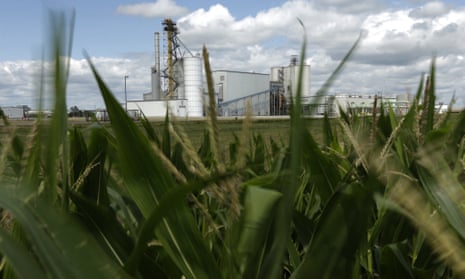Something you might have missed amid all the horserace and app-failure coverage of the Iowa caucuses: a deep discussion took place over the past year about the climate crisis and agriculture that could change the way our food system operates.
Every leading Democratic campaign now endorses an aggressive approach to conservation that could dramatically reduce greenhouse gases, improve water quality and enhance rural prosperity.
Candidates lined up to tour Matt Russell’s organic farm in central Iowa over the past year to learn about how a diversified cropping system involving livestock can suck carbon out of the air and sequester it in the soil to feed us better. Pete Buttigieg and Elizabeth Warren came up with plans that would restructure farm policy to direct funding away from subsidizing production and toward conservation. Warren would increase funding 15-fold for the Conservation Stewardship Program (CSP), to $45bn. The CSP pays farmers for regenerative agriculture practices – planting soil-saving cover crops, reducing chemical use and tillage, and all the while sequestering carbon in the soil.
Export markets for American ag commodities are falling apart. The world has been telling us through markets for years that we are growing about 30% too much corn and soy. Meanwhile, we are killing the Gulf of Mexico with excessive commercial fertilizer, which washes down the Mississippi River. California and Australia burn in part because we are spewing too much nitrogen – as problematic as CO2 for global warming – from our broken agrichemical system.
Increasing numbers of midwestern farmers who watched their fields wash away in last spring’s scouring torrents are showing up at field days offered by the Practical Farmers of Iowa, which preaches the gospel of making money on the farm by saving soil and reducing chemical costs. They watch the weather closer than anyone, and they’re ready to look into the old way of doing things – grazing in rotation with a diverse series of carbon-capturing crops – to find a way forward.
Candidates started to explore the topic at a rural forum organized in Storm Lake last March by the Iowa Farmers Union. The discussion intensified during the summer as a loose coalition of Iowans, led by the former agriculture secretary Tom Vilsack, pushed candidates to pay farmers for environmental services instead of insuring them for planting in a flood plain.
Bernie Sanders is all-in with the Green New Deal. Joe Biden, advised by Vilsack, came up with his own comprehensive plan. Buttigieg is now conversant in how microbial activity in the soil can reverse nitrogen loss to air and surface water.
Candidates embraced the idea that renewable energy – wind, solar, hydrogen – can not only ameliorate the climate crisis but also create high-paying technical jobs in rural communities hemorrhaging people.
You wouldn’t know it by the non-stop coverage of the percentage fractions separating the leading Democratic campaigns, or whether Sanders insulted Warren, or how Senator Susan Collins equivocated again after lunch. But, as the Amazon shrinks, our quiet revolution in agriculture policy might be the most important story of the news cycle.
Markets are telling us they don’t need all that corn. Iowa State University tests of the kernel tell us that soil degradation is eroding protein content. Wheat production in China is falling because of it. General Mills is up on the news, and is urging growers in the Dakotas to go organic because consumers demand it. Kellogg is phasing out glyphosate from its acres. The latest poison from Bayer, dicamba, faces a new wave of class-action lawsuits from angry farmers.
In other words, the gig is up on the last 50 years of chemical- and export-driven food production. It hasn’t worked for farmers or rural communities, and they know it.
That’s the message from the fallow fields of Iowa covered in snow, and in a few places winter rye holding soil together and nitrogen in its place. There would be a lot more of it if the government would catch on and quit rigging everything for the agrichemical supply chain.
The ball is rolling because farmers know Nature is calling the shots. Eventually politics catches up. Climate was a priority for Iowans in this cycle, unlike before. The conversation has changed, and not a moment too soon.
Art Cullen is editor of the Storm Lake Times in north-west Iowa, where he won the Pulitzer prize for editorial writing. He is author of the book Storm Lake: Change, Resilience, and Hope from America’s Heartland, recently released in paperback
